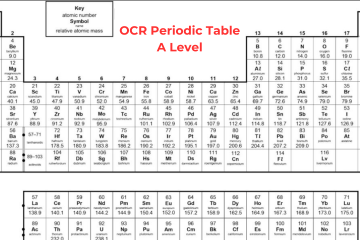What is A Level Chemistry Periodic Table?
Are you preparing for your exams and searching for the Periodic Table A Level Chemistry?
Now, let’s go through AQA Periodic Table A-Level Chemistry: The elements within the periodic table are arranged in rows called periods. They are arranged by increasing atomic number. Each successive element within a period consists of one more proton than the preceding element. The table is further organized into columns, called groups, which have elements sharing similar chemical properties. These groups are numbered one through eight, excluding the central block of elements.
Elements within the same group in the periodic table have an identical number of electrons in their outer shell, leading to analogous chemical characteristics. For instance, fluorine belongs to group 7 of the periodic table, indicating it has seven electrons in its outer shell. Similarly, other members of group 7, such as chlorine, bromine, and iodine, exhibit comparable properties and react in analogous manners. Learn Periodic Table in detail from A Level Chemistry Tutor Online at Bright Mind Tutors.
The majority of the Periodic Table A Level Chemistry has metallic elements, arranged predominantly on the left side, while non-metallic elements are predominantly arranged on the right side. The arrangement of elements in the periodic table makes it easy for us to assess the reactions they are likely to undergo:
- Elements presented in groups 1 and 2 (having either one or two electrons that they aim to lose to obtain a full outer shell) are typically involved in reactions with elements from groups 6 or 7 when creating compounds.
- Elements arranged in group 8, known as noble gases, are not likely to react with other elements due to their possession of a complete octet.
Development of the Periodic Table
Before the discovery of subatomic particles, elements were organized by atomic weight. Dmitri Mendeleev improved this by leaving gaps and rearranging elements for better grouping. Later, discoveries filled these gaps by discovering elements that fit in these gaps, and understanding isotopes clarified element placement. Today, the periodic table is organized by increasing atomic number.
Group 0
The last group of the periodic table is Group 0, it is also known as Group 8, consisting of the noble gases. These elements are all gases at room temperature and have a full outer shell of eight electrons, except for helium which has two electrons. Because they have a full outer shell, they are unreactive and do not create molecules or compounds.
As you move down Group 0, from helium to radon, the boiling point increases. This is due to the fact that the elements have more electrons, resulting in stronger intermolecular forces. These stronger forces require more energy to overcome when transitioning from a liquid to a gas state.
Group 1
Lithium, sodium, and potassium react with water strongly, forming a metal hydroxide and hydrogen gas. The metal hydroxide is an alkali, which means it releases hydroxide ions (OH-) into the solution. Since all group 1 metals react this way to form alkalis, they are known as “alkali metals”. As you move down Group 1, metals become more reactive. Lithium and sodium are quite reactive, but potassium is even more so, often resulting in explosive reactions. Elements below potassium are even more reactive but are rare and found in small amounts.
Group 7
The halogens are elements in the second-to-last group of the AQA A Level Chemistry Periodic Table. In their outer shell, they all have seven electrons, making them reactive as they only need one more to complete their octet. Halogens usually create ionic compounds with elements in Group 1, which have one outer electron that the Group 7 elements likely to take.
As you move down the halogens, from fluorine to astatine, they become darker in color and have higher boiling points. This increase occurs because each element’s mass increases, and they have more electrons around their nuclei. More electrons mean more intermolecular forces (London dispersion forces) can form.
Please check the below-mentioned AQA A Level Chemistry Periodic Table PDF as a guide for your exam preparation.
CLICK ON THIS LINK TO DOWNLOAD => AQA A Level Chemistry Periodic Table PDF
Other Useful Links:




